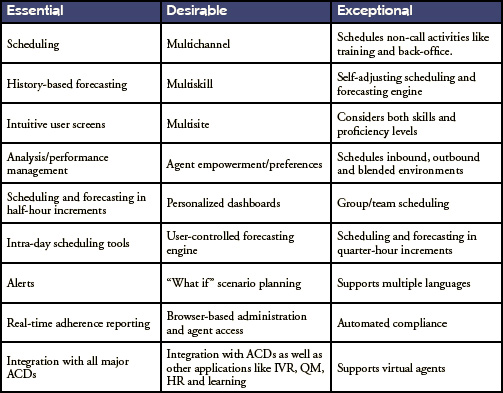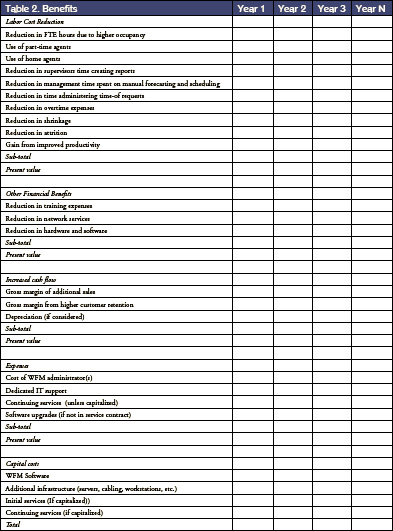|
June 2008 | Volume 27 / Number 1
Workforce Optimization
Comparing and Justifying Workforce Management SystemsBy Dick Bucci The vendor landscape for workforce management software (WFM) is thin and highly concentrated. In our recent report, “Is it Time to Invest in Workforce Management Software?” we at the PELORUS Group were able to identify only 10 sizable vendors that focused exclusively on the contact center market. Of these, the top three — Aspect, NICE/IEX (News - Alert) and Verint Witness Actionable Solutions — controlled 78 percent of the market for WFM products and services. In general, leading vendors target the larger contact centers: about 200 agents and up. These major vendors also offer very broad product portfolios; with an offer for all or most of the applications that comprise workforce optimization. The smaller vendors tend to pick their spots; addressing the smaller call centers or becoming experts in particular business types like financial services, retail or outsourcing. Before contacting vendors or preparing an RFP, it is essential to conduct internal and external research to clearly understand your requirements and get a good feel for what is out there to choose from. Once you have specified your needs – both short-term and long-term – the next step is to compare vendors. You will want to consider fundamental factors like architecture, scalability, ease-of-use, compatibility with existing infrastructure and, of course, what the system actually does. It is also very important to evaluate the vendor’s service and support program. Important questions to ask are listed below.
• Does the vendor listen to your ideas? There is also the intangible chemistry factor. Your vendor needs to be a partner in your success. Do you enjoy working with their representatives? Do you feel confident in sharing important operating information? Have you checked out their references and visited some customer sites? The Forecast And Scheduling Engine Workforce management systems use sophisticated algorithms to develop forecasts and schedules. These engines take into account past history patterns and known external factors to produce a “best fit” model to meet specified service level requirements. The mathematics of these models is beyond the scope of this article. However, you do want to know if the model is static or does it “learn” as it goes along, noting changes in call patterns and self-adjusting to fine-tune the results? For example, the system may learn how call volume changes during marketing campaigns. Or it may weigh recent information more heavily on the premise that what happened in the past few weeks is more important than what happened a year ago. It is very important that you be able to input new information such as marketing campaigns, price changes, major announcements, even changing weather conditions – all of which can affect forecasts and schedules. Regarding the design of the software, there is a definite trend toward open architecture. While this term “open” can mean different things to different people, in general it is desirable to have an architecture that is highly scalable, can readily be distributed over multiple sites and supports cost-effective integration with third-party applications and data bases. Integration For a price, literally any system or data base can be integrated with any workforce management system. But it’s a lot faster, easier and less costly if the WFM system is designed to facilitate the process. Some systems have translation layers that accept information from various outputs then stores and unifies it for seamless real-time input to the forecast and scheduling engine. Integration with the ACD is a given. Examples of other devices and databases the workforce management may have to talk to are:
Interactive voice response (IVR) Workforce management vendors often establish strong ties to ACD vendors by becoming development partners or by becoming certified on the software. The advantage to call centers is that the ACD vendor certifies that workforce management systems integrates with their call distributor and the workforce management vendor is kept abreast of design changes in the ACD which can impact the functioning of their software. Ease Of Use While hard to quantify, how easy a system is to use has a significant impact on the value you get out of it. Every call center has more turnover than it would like and there is never enough time to train everyone to the desired level of proficiency. User interfaces that are intuitive and even fun to use will foster self-learning. Graphical displays of complex statistical information make it easier to see trends and spot deviations against targets. Messaging is helpful. Supervisors can send and receive alerts and promptly notify agents if there time off or schedule change has been accepted, and why or why not. Ease-of-use, like beauty, is in the eye of the beholder. Vendor demos and user references are good ways to gather information. Features Modern workforce management software provides dozens of special features. Table 1 summarizes and prioritizes the most common ones. Vendors differ in how the features are provided.
Making The Business Case Businesses and a growing number of non-profits normally require a business case before approving substantial capital investments. A business case should not be confused with an ROI model. Experienced executives know there are many ways to work the numbers to post an attractive ROI. Indeed, no department is going to submit a capital funding request that shows an unfavorable return. Management looks at the numbers and they also look behind the numbers – to see how solid the analysis is and to assess how well the proposed investment fits with the broader of goals of the organizations. These goals include cost control and revenue growth, but also customer satisfaction, customer retention and employee loyalty. The business case captures all the reasons to make an investment in WFM, of which economics is only one. According to a study conducted in 2003 by BenchmarkPortal (News - Alert), Inc., a little more than half of call center professionals surveyed said that an ROI analysis was used to justify the purchase of their workforce management system. Building the financial case requires understanding and quantifying all of the costs and financial benefits that can realistically be attributed to the investment in workforce management technology. Table 2 is a guide to the help you identify the benefits, associated expenses and initial capital.
Today’s contact centers are remarkably efficient micro-businesses within the larger enterprise. Motivated people supported by sophisticated technologies are meeting multiple and often conflicting challenges in an environment of ever-growing complexity. Unfortunately, too many contact centers tend to operate as islands unto themselves, rather than reaching out to the broader organization to tout their contributions and share their applications. The old adage about the squeaky wheel getting the oil is all too true in large organizations. Asking for investment capital is an excellent opportunity to tell your story while pitching your case for a new or upgraded workforce management system. Given the opportunity, you should make your case in person. You can use statistics to show how well the center performs and how much more productive you can be with new technology. You can share recorded calls to demonstrate the value of the information collected each day. You can explain the costs of running a contact center as well as the financial and non-financial benefits that accrue to the enterprise. You may have to explain what workforce management software does and how it can help the contact center reduce costs and improve customer care. It is also wise to suggest ways the application can be used in other functional areas that share many of the characteristics of the contact center. It all comes down to salesmanship and the best salesman usually closes the deal. Go ahead. Be a Tiger! CiS Dick Bucci is a Senior Consultant at The PELORUS Group, an independent market research and consultancy company serving the financial services and telecommunications industries. For more information, visit www.pelorus-group.com. CIS Magazine Table of Contents |








